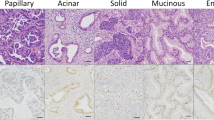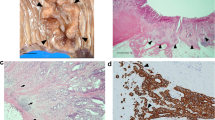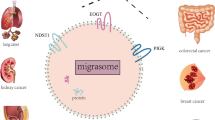Abstract
Carbonic anhydrase-related protein VIII (CA-RP VIII) is believed to be an oncofetal antigen and is overexpressed in colorectal and non-small cell lung cancer. However, the pathobiological properties of CA-RP VIII in lung cancer remain unclear. In the present study, we examined ultrastructural changes caused by exogenous CA-RP VIII expression in a well-differentiated lung adenocarcinoma cell line, PC-9. Many vacuoles lined by cilia, sometimes large vacuoles pushing the nuclei to one side, were found in the cytoplasm of CA-RP VIII-expressing PC-9 cells, but not in control PC-9 cells. Moreover, signet-ring cells containing abundant intracytoplasmic mucin were often found among CA-RP VIII-expressing PC-9 cells, but rarely among control PC-9 cells. We subsequently examined CA-RP VIII expression in atypical adenomatous hyperplasia and early-stage lung adenocarcinoma (Stage Ia). Significant expression of CA-RP VIII was observed in invasive lung adenocarcinoma but not in noninvasive adenocarcinoma. Interestingly, CA-RP VIII was strongly expressed in signet-ring cell cancer and invasive mucinous adenocarcinoma components. CA-RP VIII also appeared to enhance the invasiveness of PC-9 cells in Matrigel invasion assay. The present findings suggest that CA-RP VIII expression in lung adenocarcinoma is related to cancer cell invasion.






Similar content being viewed by others
References
Akisawa Y, Nishimori I, Taniuchi K, Okamoto N, Takeuchi T, Sonobe H, Ohtsuki Y, Onishi S (2003) Expression of carbonic anhydrase-related protein CA-RP VIII in non-small cell lung cancer. Virchows Arch 442:66–70
Hirota J, Ando H, Hamada K, Mikoshiba K (2003) Carbonic anhydrase-related protein is a novel binding protein for inositol 1,4,5-trisphosphate receptor type 1. Biochem J 372:435–441
Holting T, Zielke A, Siperstein AE, Clark OH, Duh QY (1994) Transforming growth factor-beta 1 is a negative regulator for differentiated thyroid cancer: studies of growth, migration, invasion, and adhesion of cultured follicular and papillary thyroid cancer cell lines. J Clin Endocrinol Metab 79:806–813
Kato K (1990) Sequence of a novel carbonic anhydrase-related polypeptide and its exclusive presence in the Purkinje cells. FEBS Lett 71:137–140
Kobayashi M, Nagata S, Iwasaki T, Yanagihara K, Saitoh I, Karouji Y, Ihara S, Fukui Y (1999) Dedifferentiation of adenocarcinomas by activation of phosphatidylinositol 3-kinase. Proc Natl Acad Sci USA 96:4874–4879
Ligtenberg MJ, Vos HL, Gennissen AM, Hilkens J (1990) Episialin, a carcinoma-associated mucin, is generated by a polymorphic gene encoding splice variants with alternative amino termini. J Biol Chem 265:5573–5578
Lu SH, Takeuchi T, Fujita J, Ishida T, Akisawa Y, Nishimori I, Kohsaki T, Onishi S, Sonobe H, Ohtsuki Y (2004) Effect of carbonic anhydrase-related protein VIII expression on lung adenocarcinoma cell growth. Lung Cancer 44:273–280
Miyaji E, Nishimori I, Taniuchi K, Takeuchi T, Ohtsuki Y, Onishi S (2003) Overexpression of carbonic anhydrase-related protein VIII in human colorectal cancer. J Pathol 201:37–45
Rossi G, Murer B, Cavazza A, Losi L, Natali P, Marchioni A, Migaldi M, Capitanio G, Brambilla E (2004) Primary mucinous (so-called colloid) carcinomas of the lung: a clinicopathologic and immunohistochemical study with special reference to CDX-2 homeobox gene and MUC2 expression. Am J Surg Pathol 28:442–452
Sly WS, Hu PY (1995) Human carbonic anhydrases and carbonic anhydrase deficiencies. Annu Rev Biochem 64:375–401
Smith AJ, Surviladze Z, Gaudet EA, Backer JM, Mitchell CA, Wilson BS (2001) p110β and p110δ phsophatidylinositol 3-kinases up-regulate FcɛRI-activated Ca2+ influx by enhancing inositol 1, 4, 5-triphosphate production. J Biol Chem 276:17213–17220
Takeuchi T, Kobayashi M, Moriki T, Miyoshi I (1988) Application of a monoclonal antibody for the detection of Trichosporon beigelii in paraffin-embedded tissue sections. J Pathol 156:23–27
Takeuchi T, Furihata M, Heng HH, Sonobe H, Ohtsuki Y (1998) Chromosomal mapping and expression of the human B120 gene. Gene 213:189–193
Takeuchi T, Misaki A, Liang SB, Tachibana A, Hayashi N, Sonobe H, Ohtsuki Y (2000) Expression of T-cadherin (CDH13, H-Cadherin) in human brain and its characteristics as a negative growth regulator of epidermal growth factor in neuroblastoma cells. J Neurochem 74:1489–1497
Takeuchi T, Nicole S, Misaki A, Furihata M, Iwata J, Sonobe H, Ohtsuki Y (2001) Expression of SMARCF1, a truncated form of SWI1, in neuroblastoma. Am J Pathol 158:663–672
Taniuchi K, Nishimori I, Takeuchi T, Ohtsuki Y, Onishi S (2002) Developmental expression of carbonic anhydrase-related proteins VIII, X, and XI in the human brain. Neuroscience 112:93–99
Tsuboi H, Matsui Y, Hayashida K, Yamane S, Maeda-Tanimura M, Nampei A, Hashimoto J, Suzuki R, Yoshikawa H, Ochi T (2003) Tartrate resistant acid phosphatase (TRAP) positive cells in rheumatoid synovium may induce the destruction of articular cartilage. Ann Rheum Dis 62:196–203
Tsuta K, Ishii G, Yoh K, Nitadori J, Hasebe T, Nishiwaki Y, Endoh Y, Kodama T, Nagai K, Ochiai A (2004) Primary lung cancer with signet-ring cell cancer components: clinicopathological analysis of 39 cases. Am J Surg Pathol 28:868–874
Xu Q, Karouji Y, Kobayashi S, Ihara S, Konishi H, Fukui Y (2003) The PI3-kinase-Rac-p38 MAP kinase pathway is involved in the formation of signet-ring cell carcinoma. Oncogene 22:5537–5544
Acknowledgements
We thank Mr. Yamaguchi, Takuya, Ms. Nakamura, Naoyo (Department of Pathology, Kochi Medical School), and Ms. Matumura, Rumi (Division of Molecular Biology, Kochi Medical School) for skillful technique. This study was supported by grants from the Japanese Ministry of Education, Science, and Culture (KAKEN 17590270, 17590654, 15590656) and the Medical Research Fund of Kochi Medical School.
Author information
Authors and Affiliations
Corresponding author
Rights and permissions
About this article
Cite this article
Ishihara, T., Takeuchi, T., Nishimori, I. et al. Carbonic anhydrase-related protein VIII increases invasiveness of non-small cell lung adenocarcinoma. Virchows Arch 448, 830–837 (2006). https://doi.org/10.1007/s00428-006-0199-0
Received:
Accepted:
Published:
Issue Date:
DOI: https://doi.org/10.1007/s00428-006-0199-0




